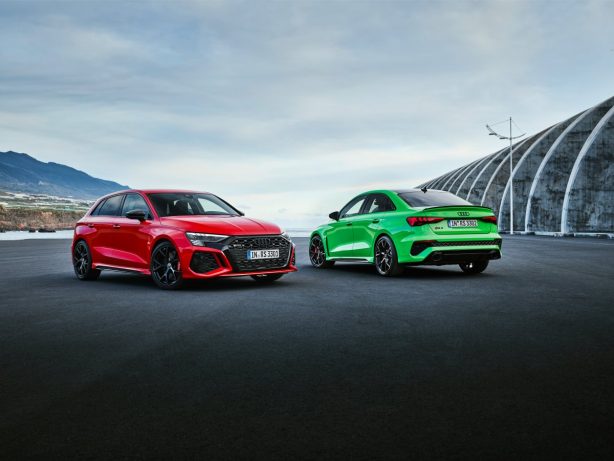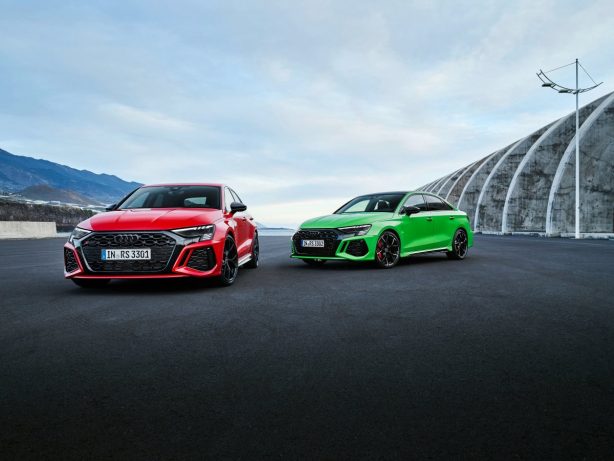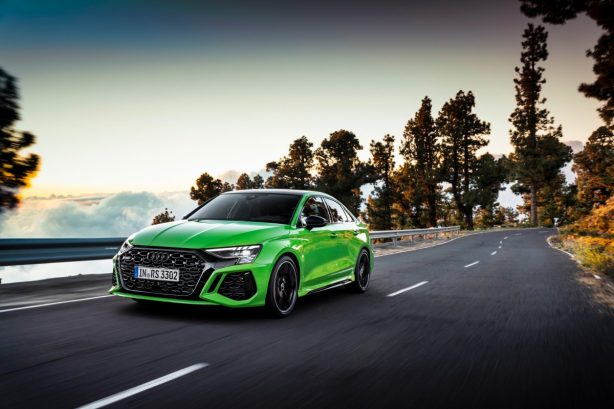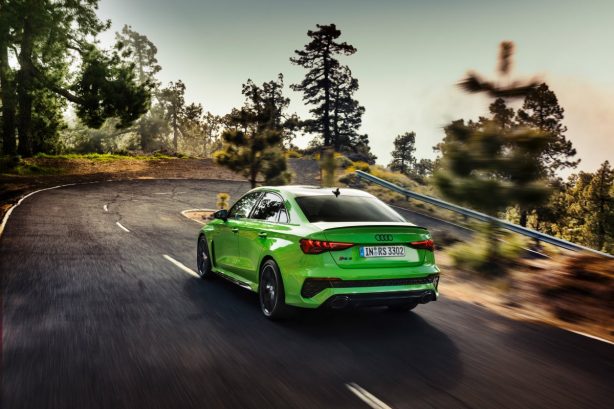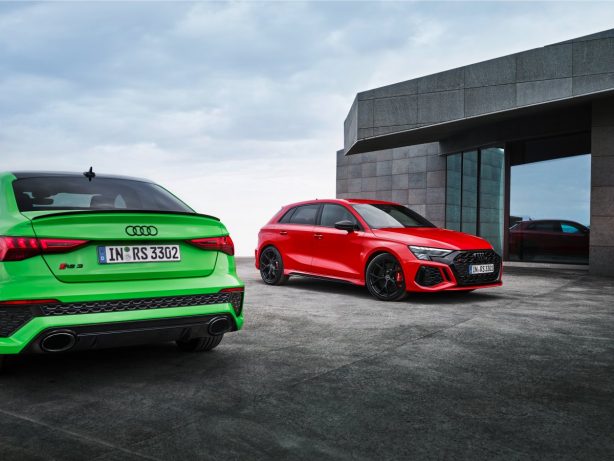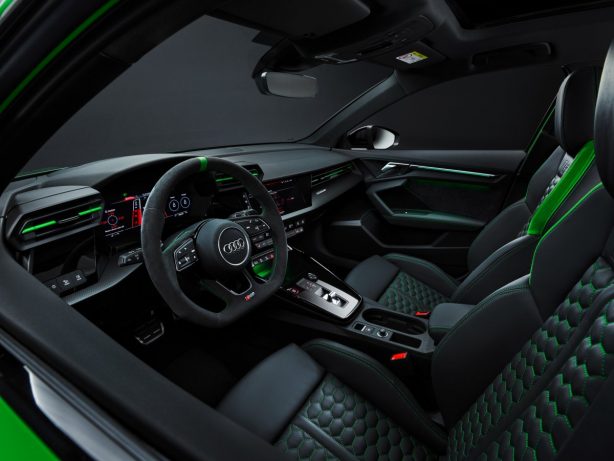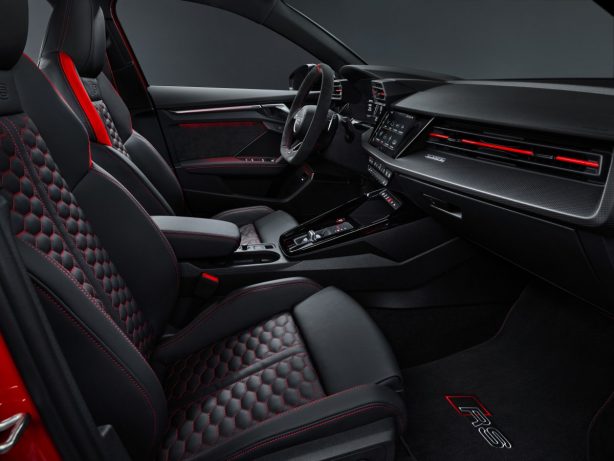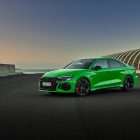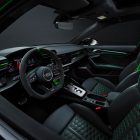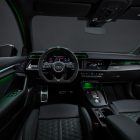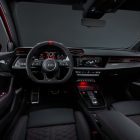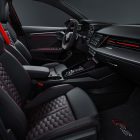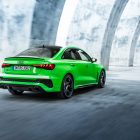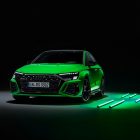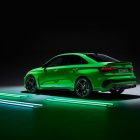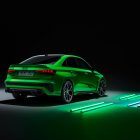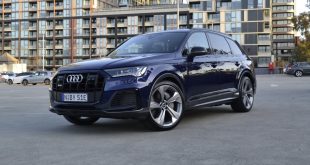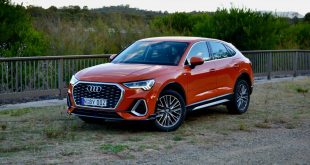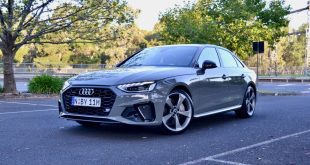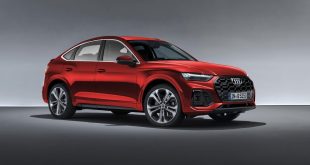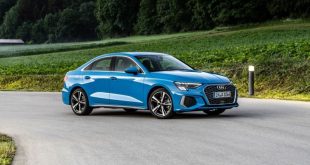The new Audi RS 3 is quite possibly the last ICE (Internal Combustion Engined) RS 3 before some sort of electrification is introduced in the next generation model. For this final ICE send off, Audi has thrown in everything it has got to make this the fastest, sharpest and baddest RS 3 ever.
At the heart of the RS 3 is of course the iconic five-cylinder engine. Already a beast in the outgoing model, the 2.5-litre turbo TFSI engine has been tweaked further in this new model to wring out another 20Nm of torque. It now peaks 500Nm, sustained between 2,250 and 5,600rpm. Peak power is unchanged at 294kW, but available earlier than before at 5,600rom and extends over a broader plateau to 7,000 rpm.
As a result, the new RS 3 sprints from zero to 100 km/h in supercar-slaying 3.8 seconds. Top speed is limited to 250 km/h, but 280 km/h is possible through an optional upgrade. With the RS Dynamic package and ceramic brakes, it can even crack 290 km/h. This makes the Audi RS 3 the best in its class in terms of acceleration and top speed.
As with before, 7-speed dual-clutch transmission sends power to the road with the aid of Quattro all-wheel drive. But new is the torque splitter equipped as standard across all RS 3 models. It replaces the rear axle differential and the previous multiple disc clutch package on the rear axle. Instead, an electronically controlled multiple disc clutch is used on each of the drive shafts to more precisely vary torque distribution at the rear axle. During hard cornering, the torque splitter increases the drive torque to the respective outer rear wheel with the higher wheel load, which significantly reduces understeer. In left-hand curves, it transmits the drive torque to the right rear wheel, in right-hand curves to the left rear wheel, and when driving straight ahead to both wheels.
The new torque splitter also makes controlled drifts on closed-off tracks possible – in this case, the torque splitter directs all of the power to only one of the rear wheels. Audi even developed a driving mode specifically for the RS 3 for this purpose – ‘RS Torque Rear’ – as a drift mode with its own characteristic curve for the torque splitter.
The RS Performance mode, created specifically for the racetrack, is another new drive mode that is precisely tailored to the semi-slick tyres that are, for the very first time, available for the RS 3 as a factory option.
The drive modes can be selected via the Audi drive select driving dynamics system, which also offers the following profiles: comfort, auto, dynamic, RS Individual, and efficiency.
The RS 3 comes standard-equipped with larger and newly developed six-piston steel brakes to keep the power of the five-cylinder engine in check. A ceramic brake system measuring 380 by 38 mm is optionally available on the front axle. Those who opt for the ceramic brakes can choose between gray, red, or blue brake calipers, while those who prefer the steel version can order red calipers instead of the black ones.
In terms of design, the new Audi RS 3 looks even more dynamic and powerful than that of its predecessor. In the front, the wide RS bumper, the redesigned Singleframe with its distinctive honeycomb grille, and the large air intakes give the compact sports car an aggressive look.
The RS 3 comes standard with flat, wedge-shaped LED headlights and LED taillights including dynamic turn signal lights. Matrix LED headlights are available as an option, with darkened bezels that feature digital daytime running lights around their outer downturned angles. With its pixel field of 3 x 5 LED segments, it provides an unmistakable look – a checkered flag appears in the left headlight as a dynamic leaving and coming home scene, and the RS 3 lettering appears on the driver’s side. When driving, the checkered flag lights up on both sides.
There is also a new design element behind the front wheel arches: an air outlet. The rocker panels with black trim have also been redesigned and, in combination with the flared wheel arches, contribute to the dynamic look of the new RS 3. The front axle track has been widened by 33 millimetres compared to the previous model. On the Sportback, the rear axle track has increased by ten millimeters. The RS 3 is standard-equipped with 19-inch cast wheels in a 10-Y spoke design. True racing design is embodied by the optionally available 5 Y spokes with RS branding. Audi will also mount Pirelli P Zero ‘Trofeo R’ performance semi-slick tires for the first time, if desired.
The motorsports-inspired finishing touches include the redesigned RS-specific rear bumper with integrated diffuser and the RS exhaust system with two large oval tailpipes.
The new Audi RS 3 models can be ordered in two exclusive RS colors: Kyalami green and Kemora gray. The roof of the Sedan can also be ordered in the contrasting color Brilliant black for the first time. Individual exterior features, such as the honeycomb grille in the Singleframe, come standard in black – either in a matte or high-gloss finish.
On the inside, The RS 3 gets a range of bespoke RS touches. The displays appear in the standard 12.3-inch Audi virtual cockpit plus digital driving instrumentation cluster. It displays the rpms in the form of a bar graph and shows power and torque as percentages. Optionally, the rpm display is available in the new ‘RS Runway’ design. In this case, the values are displayed in the opposite direction in a manner that visually resembles an airplane runway – the highest speed in the foreground and the lowest speed in the background. In addition, the Audi virtual cockpit plus includes displays for g-forces, lap times and acceleration from 0 100 km/h, 0-200 km/h, quarter mile, and eighth of a mile.
The 10.1-inch touchscreen centre display includes what is referred to as the ‘RS Monitor,’ which displays the coolant, engine, and transmission oil temperatures as well as tire pressures. Also available for the first time for the Audi RS 3 is a head-up display.
The genuine racing feeling is further enhanced by the carbon-fiber instrument panel and RS sport seats with RS embossing and anthracite contrast stitching. The seat upholstery is optionally available in fine Nappa leather with RS honeycomb stitching and glossy black, red, or, for the first time, green contrast stitching. RS Design packages in red and green are available to match. They include special floor mats with contrast stitching and RS embroidery, as well as seatbelts with colored edges. The Design package plus includes seat corners in red or green and a colored accents on the air vents.
The new Audi RS 3 Sportback and RS 3 Sedan is expected to arrive in Australia in the first half of 2022. Further information on pricing and specfiication details will be announced closer to launch.
 ForceGT.com Car News, Car Reviews, Video Reviews, Tuning and much more.
ForceGT.com Car News, Car Reviews, Video Reviews, Tuning and much more. 